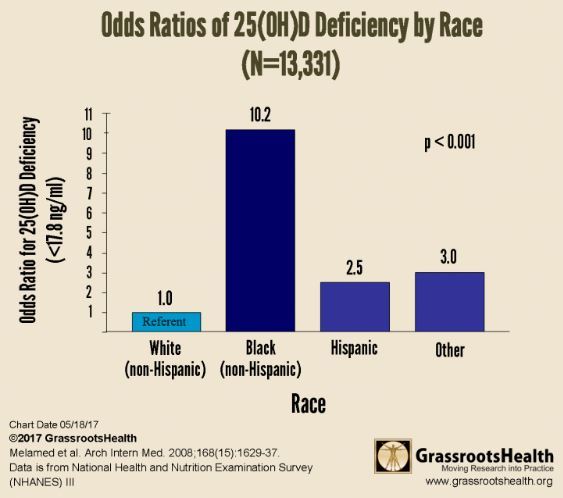Blacks are more obese, have lower Vitamin D, and have more Cancer etc. than whites
Obesity and vitamin D status may help explain the racial and ethnic disparities in ampullary cancer survival rates
J. SURGICAL ONCOLOGY 2017;1
vs White | White - low D
vs White - high D | | breast cancer | 1.34 | 1.26 | | colorectal cancer | 1.43 | 1.44 | | cardiovascular disease | 1.29 | 1.27 | | all-cause mortality | 1.26 | 1.26 | --- 1. # Items in both categories Obesity and Skin-Dark are listed here: {category} --- 1. Blacks 10X more likely to have low Vitamin D

📄 Download the PDF from Sci-Hub via VitaminDWiki
To the Editor:
The recent paper by Nassour and colleagues reported race/ ethnicity disparities in ampullary cancer survival. Median survival times were
18.9 months for blacks,
23.9 months for whites,
32.7 months for Hispanics, and
37.4 months for Asians.1
Some factors related to survival such as socioeconomic status and treatment utilization were mentioned but thought not to explain all of the disparities.
One factor overlooked is the race/ethnicity prevalence of obesity. Obesity is an important risk factor for adverse effects on the gastrointestinal tract2 and cancer in general.3 In the period 2011-2014,
obesity rates in the US were
48.1% for non-Hispanic black,
42.8% for Hispanic,
34.5% for non-Hispanic white, and
11.7% for non- Hispanic Asian.4
A linear two-tailed regression fit to the data is Survival rate = 38.4-0.37 x Obsesity rate, r = 0.94, P = 0.06. Thus, obesity rates may help explain the relative survival rates for blacks and Asians compared to Hispanics and whites.
Another overlooked factor is vitamin D status. There is mounting evidence that vitamin D reduces incidence and mortality rates for many types of cancer, and the mechanisms whereby vitamin D reduces risk of cancer and increases survival are well known.5-8 Vitamin D status has been suggested to explain the portion of reduced survival for blacks compared to whites for many types of cancer.9
Older black Americans have mean 25-hydroxyvitamin D concentrations of about
16 ng/mL,
Hispanics 21 ng/mL, and
whites, 26 ng/mL.10
Those 25- hydroxyvitamin D (25[OH]D) concentrations are inversely related to survival times for blacks, Hispanics, and whites. A linear two-tailed regression fit to the data is Survival rate = -3.8 + 1.4 x 25(OH)D, r = 0.98, P = 0.10. In addition, 25(OH)D concentrations are generally inversely correlated with body mass index. While it would be difficult for ampullary cancer patients to reduce their body weight, it would be easy to increase 25(OH)D concentrations. Raising concentrations to 40-60 ng/mL using 5000-10 000 lU/d vitamin D3 should be considered.
DISCLOSURES: I receive funding from Bio-Tech Pharmacal (Fayetteville, AR, USA).
William B. Grant, PhD, Sunlight, Nutrition, and Health Research Center, P.O. Box 641603, San Francisco, CA 94164-1603. wbgrant@infionline.net
REFERENCES
Nassour I, Mokdad AA, Minter RM, et al. Racial and ethnic disparities in a national cohort of ampullary cancer patients. J Surg Oncol. 2017. https://www.ncbi.nlm.nih.gov/pubmed/28968918. https://doi.org/10.1002/jso.24835. [Epub ahead of print].
Feakins RM. Obesity and metabolic syndrome: pathological effects on the gastrointestinal tract. Histopathology. 2016;68:630-640.
Steele CB, Thomas CC, Henley SJ, et al. Vital signs: trends in incidence of cancers associated with overweight and Obesity-United States, 2005-2014. MMWR Morb Mortal Wkly Rep. 2017;66:1052-1058.
Ogden CL, Carroll MD, Fryar CD, Flegal KM. Prevalence of obesity among adults and youth: United States, 2011-2014. NCHS Data Brief. 2015;(219):1-8. https://www.ncbi.nlm.nih.gov/pubmed/2663 3046
Grant WB. Roles of solar UVB and vitamin D in reducing cancer risk and increasing survival. Anticancer Res. 2016;36:1357-1370.
Moukayed M, Grant WB. The roles of UVB and vitamin D in reducing risk of cancer incidence and mortality: a review of the epidemiology, clinical trials, and mechanisms. Rev Endocr Metab Disord. 2017; 18:167-182.
Grant WB, Boucher BJ. Randomized controlled trials of vitamin D and cancer incidence: a modeling study. PLoS ONE. 2017;12:e0176448.
Tretli S, Schwartz GG, Torjesen PA, Robsahm TE. Serum levels of 25- hydroxyvitamin D and survival in Norwegian patients with cancer of breast, colon, lung, and lymphoma: a population-based study. Cancer Causes Control. 2012;23:363-370.
Grant WB, Peiris AN. Differences in vitamin D status may account for unexplained disparities in cancer survival rates between African and White Americans. Dermatoendocrinol. 2012;4:85-94.
Ginde AA, Liu MC, Camargo CA, Jr. Demographic differences and trends of vitamin D insufficiency in the US population, 1988-2004. Arch Intern Med. 2009;169:626-632.
